Benin is probably the Gulf of Guinea’s least-known nation. Though small with an area of 113,000 square kilometres and a population of 9 million, Benin is charming and enchanting. Our truck reached most corners of Benin bringing me to the northern upland, the south and the coast. My visit to the Royal Palace of Abomey (a World Heritage Site), the Pendjari National Park, Ganvie, the Somba villages, Ouidah and Grand Popo all exceed my expectations.
Background
Benin has an intriguing past and interesting modern history. Africans from various parts had migrated and settled in Benin. This explains the wide variation in social organization and cultural practices. Fon, Adja and Yoruba account for 60% of the population.
Benin is the birthplace of Voodooism which has been recognized as a religion. The far north was partly controlled by the Niger River’s Songhai Empire in the 15th century. The south was ruled by local rulers when the European traders, missionaries and colonizers arrived in droves. The coast of Benin was an important slave trading centre where over 10 million slaves had been shipped to Brazil.
By the beginning of the 18th century, the Dan-Homey kingdom with 12 kings (1620-1900) emerged as the dominating force in the region. Under king Agadja (1708-40), the kingdom conquered smaller kingdoms and the territory reached the coast. In the meantime, the French gradually consolidated their control in the region. In 1863, King Toffa of Porto Novo became a French protectorate. In 1868, King Glele ceded rights to Cotonou to the French. King Behanzin (1889-94) refused to recognize French rights over Cotonou and attacked the city in March 1890 and surrounded Porto Novo a month later. Following other skirmishes and threats by King Behanzin, the French began its conquest in August 1892 with Senegalese and Hausa infantry and marched on Abomey in November 1892. King Behanzin was captured two years later and was exiled in Martinque. In 1904, Dahomey became part of French West Africa.
During the colonial era, the French catholic missions played an important part in education and shaping up French policy in Dahomey. By mid 1950s, many middle-ranking posts in the civil service across the French West Africa were held by Dahomeyans. Pre-independence politics were dominated by ethnic and regional interests. Hubert Maga, Migan Apithy and Justin Ahomadegbe representing the north, the southeast and the southwest respectively, were the three key political figures.
The Republic of Dahomey was established on August 1, 1960. Hubert Maga became president. Political riots broke out by 1963 and Maga was deposed in a peaceful coup led by Colonel Christopher Soglo who restored civilian rule with elections (which were not considered democratic) taking place in 1964. Apithy became President and Ahomadegbe the Prime Minister. Exclusion of the north resulted in riots in Parakou and the military led by Soglo stepped in again. As the provisional government brought no peace, Soglo stepped in for the third time and took charge for two years. The military government was discredited as a result of rampant corruption and was replaced after a coup led by Major Maurice
Kouandete. A further period of political instability followed. Kouandete was prevented by his fellow officers to take power. A Military Directorate was established with Lt-Colonel Paul Emile de Souze in charge.
Regional self-interest continued to dominate and a Presidential Council was finally formed in 1970 in which Maga, Apithy and Ahomadegbe agreed to rotate power every two years. Maga was the first to serve and was replaced by Ahomadegbe in 1972. However, army rivalries and mutinies triggered off another coup and Major Mathieu Kerekou from Natitingou took over in October 1972.
In 1974, Kerekou took the nation on a popular revolution path based on Marxism-Leninism. Economy was centralized and schools were nationalized. Committees were established to promote participation in local government. In 1975, he changed the name of the country to the People’s Republic of Benin.
In 1977, a new law provided for new political structures including a 336-member national revolutionary assembly. In 1979, Kerekou, the sole presidential candidate was elected president by the assembly. His new economic policy did not work and his government had to embark on a path of liberalization to regenerate the ailing economy and to seek international aid. State-run companies were sold off or reformed.
In 1989, there were widespread demonstrations calling for Kerekou’s resignation, the adoption of a multiparty system and economic reforms. In March 1990, a national conference was held and established a new framework for the country’s future. The communist ideology was dropped. The conference declared it sovereignty and reduced Kerekou to a figurehead and appointed a new cabinet led by Nicephore
Soglo, a former World Bank official. The referendum held in August 1990 supported the conference’s draft constitution
and Soglo beat Kerekou in the 1991 presidential elections.
While normalcy returned to some extent, the political scene remained murky. In the 1996 elections, Kerekou with the support of the small parties beat Soglo and became president again. Dissatisfaction over the economy, corruption and austerity measures adopted by the government
finally led to a series of strikes in 1998. Kerekou beat Soglo and Adrien Houng-bedji and was elected president again in 2001. A new face, Thomas Yayi, a former head of the West African Development Bank was elected President in the 2006 elections and re-elected in 2011.
Economy
Benin has a small and underdeveloped economy and dependent on subsistence farming, cotton production and regional trade. The GDP (official rate) and GDP (purchasing power parity) was estimated to be US$7.5 billion and US$14.8 billion (2011). The GDP per capita (PPP) was US$1,500 (2011). Over a third of its population lives below poverty line.
Day 15 (January 19): Abeokuta, Nigeria – Abomey, Benin (200km; 6 hrs)
After spending some two hours at the Nigeria border, we had to find our way to the Benin side as there is no physical boundary! We finally arrived outside a nice two-storied police building. Mike took our passports and we got our stamps within 15 minutes without hassles!
I found myself not only in a different country but a different world which seems orderly, clean and lush green. Though the visibility was not too good as a result of the Harmatten wind from the Sahara, I enjoyed the scenery which is pleasant, green with ponds, rivers, and palm and citron trees. The 2-lane road is well paved without pot holes and the huts/houses, schools and clearings along the road are tidy and clean.
I was on meal duty again. We did our shopping in Abomey’s central market and arrived in Chez Monique just before night fall. We had a good dinner with sausages and potatoes. I took a room for US$15 a night and had a nice sleep.
Day 16: Abomey
We had a leisure day. I got up at 6am and went to a place with internet close to Chez Monique. I waited for an hour till 9am but the person in charge did not turn up! After breakfast, we had a guided tour to the Royal Palace of the Dan-Homey kingdom (1620-1900) which now houses the Museum of History.
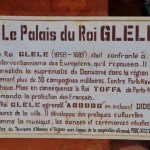 Our English-speaking guide gave us detailed explanations about the history of the kingdom and the typical design and layout of a palace. Ten out of the 12 kings of the kingdom had their palaces in Abomey. Today only the palaces of King Ghezo (1818-58) and his son and successor Glele (1858-89) remain intact. We saw the thrones and the residences of the kings and visited the tomb of King Glele. Walls of the long complex where the king had meetings have colourful bas-relief. Though the museum and the two palaces are modest, the display and illustrations are generally good. With the guide repeating most things twice or thrice, I learn the history of this glorious kingdom where the king traded 15 healthy men or 21 women for a canon which he used to conquer or protect his kingdom. Then many died on the way to the new world or as a slave! How cruel!
Our English-speaking guide gave us detailed explanations about the history of the kingdom and the typical design and layout of a palace. Ten out of the 12 kings of the kingdom had their palaces in Abomey. Today only the palaces of King Ghezo (1818-58) and his son and successor Glele (1858-89) remain intact. We saw the thrones and the residences of the kings and visited the tomb of King Glele. Walls of the long complex where the king had meetings have colourful bas-relief. Though the museum and the two palaces are modest, the display and illustrations are generally good. With the guide repeating most things twice or thrice, I learn the history of this glorious kingdom where the king traded 15 healthy men or 21 women for a canon which he used to conquer or protect his kingdom. Then many died on the way to the new world or as a slave! How cruel!
I spent the next two hours in this internet place. It was most frustrating as the internet service was very slow. Also the French keyboard drives me crazy as well!
Ant offered to prepare dinner. For the first time on this tour, I had half of a grilled chicken. Though the meat was a bit tough, I enjoyed the grilled chicken very much.
Day 17: Abomey – Bohicon – South Bassila (250km; 5hrs)
Our next destination is the Pendjari National Park which is over 400km in the north. Mike decided to start early and bush camp along the route. As the battery had gone flat, Mike and Ant spent over an hour to fix it and another half an hour to fill the water tanks. Before heading north, we shopped in Bohicon getting the provisions we needed for the next three days. We finally set off around 11am.
After a long day’s driving, Mike spotted a nice school ground before it got dark. With the permission from the school, we set up our tents under the gaze of dozens of villagers.
I was hot and desperate for a cold shower. A beautiful young lady offered to bring me a bucket of water from the well. I rushed back to the camping ground to pick up shampoo, soap and clean clothes. Rick also wanted a shower and followed me to the village. The shed for villagers to take showers is simple but clean. I gave the lady some money for her kindness and she was delighted.
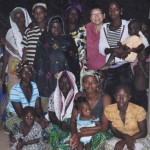 |
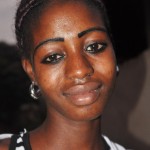 |
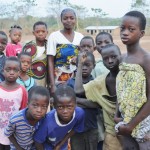 |
After dinner, another young lady invited me to visit her home. I gladly took up the offer. She is 22 years-old with a 2-year old son. She said ‘my husband is no good and we are divorced’ and has moved to Cotonou to work as a dress-maker while leaving her son with her parents. But she still hopes to have three more children! I was introduced to her younger brother and her 48-year-old father who is a doctor with 15 children! She asked me why I am not married and why I do not have children. As it started to rain, she walked me back to the camp site and asked me to marry her father or her younger brother and stay. A most impossible suggestion! I am also puzzled by these people’s attitude towards marriage.
We had lightning and heavy rainfall. As Dara and I had already put the rain cover over the tent, we stayed dry. But the tent was hot and I did not sleep well.
Day 18: South Bassila – Natitingou–Pendjari Park (250km; 9hrs)
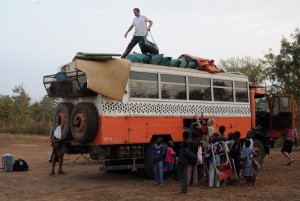 We had an hour’s break at Natitingou, home town of former President Kerekou. The internet works and I was pleased to get an email from Lawrence, my brother confirming my flight details to Canada in late March.
We had an hour’s break at Natitingou, home town of former President Kerekou. The internet works and I was pleased to get an email from Lawrence, my brother confirming my flight details to Canada in late March.
The paved road ended in Tanguieta and we were on the red piste all the way to the park entrance at Tanougou. But the red piste is in good condition without many pot holes. We reached Tanougou at 4pm and spent over half an hour for registration. Though the camp site at Mare Yangouali is only about 70km away, it took us almost three hours to get there. We were greeted by the loud snarling noises from hippos which stay in the river next to the camp site. The site is not big and we set up the tents close together in order to be out of the hippo trail.
Day 19: Pendjari Park
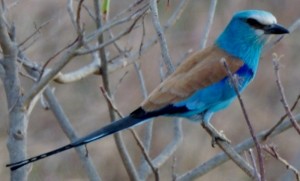 Pendjari Park with an area of over 2,750 square kilometres of woody savannah spreading across Benin, Burkina Faso and Niger, is said to be one of the best game reserves in West Africa. Ant heard the lion roaring around 6:30am.We set off for a game-drive at 6:45am. As expected, there was no gorgeous sunrise as visibility remained relatively poor owing to the sand dust.
Pendjari Park with an area of over 2,750 square kilometres of woody savannah spreading across Benin, Burkina Faso and Niger, is said to be one of the best game reserves in West Africa. Ant heard the lion roaring around 6:30am.We set off for a game-drive at 6:45am. As expected, there was no gorgeous sunrise as visibility remained relatively poor owing to the sand dust.
During the 3-hour drive, we saw a few topis, warthogs, monkeys and baboons, several herds of elephants and buffaloes and numerous antelopes. While we saw plenty of eyes and ears of crocodiles and hippos on the water surface, none of them got out of the water. Some French tourists told us that they had seen a lion near our camp site five minutes before our arrival.
 Cook team 1 with Rick, Dara and Secona served us excellent pancakes for reakfast. I had a relaxing morning writing p my travel notes on Nigeria before setting off for another game drive from 3 to 7 pm. We saw many animals except lions and cheetahs.
Cook team 1 with Rick, Dara and Secona served us excellent pancakes for reakfast. I had a relaxing morning writing p my travel notes on Nigeria before setting off for another game drive from 3 to 7 pm. We saw many animals except lions and cheetahs.
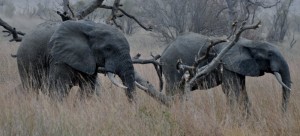 I was surprised to find a motor home parked next to my tent. I later found out that the English couple left England last November and would be spending three more months in West Africa. I envy their 5-star Mercedes-Benz motor home which is well-equipped and comfortable with plenty of storage, a toilet with shower and a kitchen with oven, fridge and freezer! That evening, Naomi did not feel well. Jens and I prepared a pasta lunch for the following day.
I was surprised to find a motor home parked next to my tent. I later found out that the English couple left England last November and would be spending three more months in West Africa. I envy their 5-star Mercedes-Benz motor home which is well-equipped and comfortable with plenty of storage, a toilet with shower and a kitchen with oven, fridge and freezer! That evening, Naomi did not feel well. Jens and I prepared a pasta lunch for the following day.
Day 20: Pendjari Park -Tanougou -Tanguieta (150km; 5 hrs)
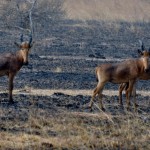 I cooked porridge for breakfast. Lisa, Naomi and Peter all did not feel well. We set off at 10am and made our way to Mare Bali to watch animals coming to drink by the lake. There were some birds and crocodiles.
I cooked porridge for breakfast. Lisa, Naomi and Peter all did not feel well. We set off at 10am and made our way to Mare Bali to watch animals coming to drink by the lake. There were some birds and crocodiles.
After lunch, we headed south. While we were refilling the water tanks at Tanougou around 2:30pm, Jess passed out and Mike rushed her to the nearest hospital at Tanguieta. Lisa and Naomi also decided to take a test. Ant took us to a nearby hotel where we camped for the night.
Mike returned with the news that Jess had malaria. Though testing results for malaria for Lisa and Naomi was negative, they would spend a night at the hospital to receive medication. We were all concerned about the three girls’ condition.
I had no shower for two days and was relieved when I could shower before going to bed. We had dinner at the hotel. I ordered mutton and rice and had to wait for over two hours. I cannot understand why the chef would take so much time to prepare a simple meal. Perhaps they had to catch the sheep. Peter, a young and tough Dutchman, had an upset stomach and skipped dinner. Not a good sign (See Part 2).


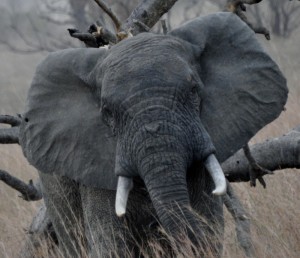
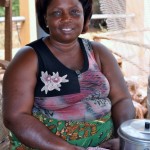
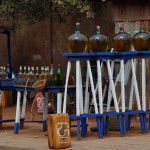
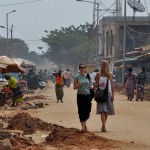
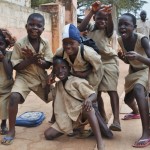
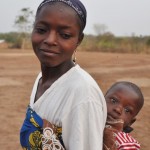
Hey Sarah!
It was great to meet you in D’Abomey and we hope that you are enjoying the rest of your extra time in Benin!
Tomorrow we are off to Cameroon, hopefully that is since it is proving rather more difficult than expected to actually pay for a flight!
It will be a matter of turning up at the airport and hoping for the best!
Cool blog and website, hope you see/saw some lions!
Best wishes,
Chris and Brad
Guess you’re still in West Africa …. just sending a Chinese New Year greeting.
Wish you a healthy, happy and prosperous Year of the Dragon.
Hi Sarah. It has been great being you tent buddy the past few weeks. I look forward to reading about the rest of your travels and seeing where our paths cross again!